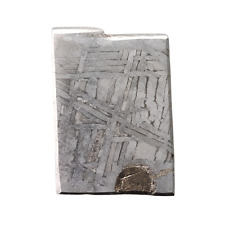15.8g Iron Meteorite Windowed [Iridium Cobalt Nickel]:Ancient Fall::New Find: For Sale
![15.8g Iron Meteorite Windowed [Iridium Cobalt Nickel]:Ancient Fall::New Find: 15.8g Iron Meteorite Windowed [Iridium Cobalt Nickel]:Ancient Fall::New Find:](img-large/g/eXEAAOSw-slmGxgw/s-l1600/15-8g-Iron-Meteorite-Windowed-Iridium-Cobalt-Nicke.jpg)
When you click on links to various merchants on this site and make a purchase, this can result in this site earning a commission. Affiliate programs and affiliations include, but are not limited to, the eBay Partner Network.
15.8g Iron Meteorite Windowed [Iridium Cobalt Nickel]:Ancient Fall::New Find::
$37.50
This is a rare and genuine IAB iron meteorite from outer space. These meteorites are characterized by their iron-nickel composition and distinctive octahedral shape. The IAB type is one of the most well-known and sought-after types of iron meteorites, and they are considered to be some of the oldest objects in the solar system, dating back over 4 billion years.To ensure the legitimacy of this specimen, it has been authenticated by a professional meteorite expert using industry standard methods, such as composition analysis and microstructural examination.
Don't miss this opportunity to own a piece of history from beyond our planet. Add this IAB iron meteorite to your collection today!IAB iron meteorites are a type of meteorite that are composed primarily of iron and nickel. These meteorites are believed to have originated from the cores of asteroids that have been shattered by impacts with other celestial bodies.
One of the unique characteristics of IAB iron meteorites is that they are not magnetic. This is because the iron and nickel in these meteorites is not in the form of ferromagnetic minerals, such as magnetite or hematite. Instead, the iron and nickel in IAB meteorites is found in the form of kamacite and taenite, which are both non-magnetic minerals.
The lack of magnetism in IAB iron meteorites can be used to distinguish them from other types of iron meteorites, such as IIIAB and IVB meteorites, which are magnetic. This IAB iron meteorites are a type of meteorite that are composed primarily of iron and nickel. These meteorites are believed to have originated from the cores of asteroids that have been shattered by impacts with other celestial bodies.
One of the unique characteristics of IAB iron meteorites is that they are not magnetic. This is because the iron and nickel in these meteorites is not in the form of ferromagnetic minerals, such as magnetite or hematite. Instead, the iron and nickel in IAB meteorites is found in the form of kamacite and taenite, which are both non-magnetic minerals.
The lack of magnetism in IAB iron meteorites can be used to distinguish them from other types of iron meteorites, such as IIIAB and IVB meteorites, which are magnetic. This is because IIIAB and IVB meteorites contain a higher amount of ferromagnetic minerals, such as magnetite and hematite, which give them their magnetic properties.
IAB iron meteorites are also relatively rare, with only around 100 known meteorites having been classified as IAB. This is in contrast to other types of iron meteorites, such as IIIAB and IVB meteorites, which are much more common.
Despite their rarity, IAB iron meteorites have been found in various locations around the world, including Africa, Antarctica, Australia, and the United States. These meteorites are believed to have fallen to Earth during the time period between 4.5 billion and 4.6 billion years ago, which is when the solar system was still in its early stages of formation.
IAB iron meteorites have also been found to contain small amounts of other elements, such as cobalt and phosphorous. These elements are believed to have been incorporated into the meteorites during their formation in the asteroid cores.
In addition, IAB iron meteorites have also been found to contain small amounts of the element iridium. Iridium is a rare element on Earth, but is found in high concentrations in some meteorites. This has led scientists to believe that IAB iron meteorites may have played a role in the formation of the solar system.
Overall, IAB iron meteorites are unique in that they are not magnetic and are believed to have originated from the cores of shattered asteroids. They are relatively rare and have been found in various locations around the world. The study of these meteorites can provide valuable insights into the early stages of the formation of the solar system.Meteorite Metals Composition
MODE [precious metals] 2
Iridium .3%Nickel 5.46%CobaltIron 93%ChromiumCelestial Pebbles Cosmic Stones Stardust Fragments Heavenly Boulders Astral Nuggets Galactic Pebbles Shooting Stars' Remnants Comet Chunks Meteoric Marbles Nebulae Fragments Interstellar Gravel Space Gemstones Meteor Shower Shrapnel Universe's Debris Space Debris Diamonds Comet's Tail Relics Astrological Bricks Galactic Grains Interplanetary Nuggets Stellar Shrapnel Orbital Treasures Starfall Fragments Cosmic Splinters Asteroidal Clusters Heaven's Marbles Galactic Dust Specks Planetesimal Gems Space Odyssey Stones Meteorite Mosaic Pieces Nebular Fragments Lunar Marbles Aurora Shards Starborn Residues Celestial Eclipses Comet Tidbits Stellar Nuclei Asterism Fragments Supernova Stones Meteorite Medley Solar Flare Pebbles

Related Items:
15.8g Muonionalusta meteorite slice QC196
$24.92

